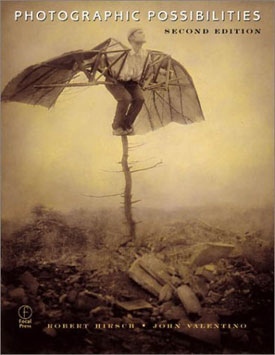 Photographic Possibilities: The Expressive Use of Ideas, Materials, and Processes, 2nd edition Photographic Possibilities: The Expressive Use of Ideas, Materials, and Processes, 2nd edition
Robert Hirsch and John Valentino
Focal Press, $36.95
ISBN 0-240-80362-0

Review by Bruno Chalifour
From Vol. 2 No. 5
Photographic Possibilities is the third technical book written by Robert Hirsch, this time with the collaboration of John Valentino. This is the second edition, the first was released in 1991. This new book is designed “for the individual who has acquired a keen interest [and practice] and desires to learn a variety of processes as a means of reaching new visual goals.” The two noticeable changes in the current edition, notwithstanding the updating of several articles, are its pedagogical, historical, and at times philosophical introduction, and the two chapters on which John Valentino worked, dedicated to digital imaging.
The book starts with “Why We Make Photographs: Ideas and History that Affect Photographic Print-making.” It presents, in a synthesized form, the experiences and notes collected by the author over the course of some two decades spent teaching photography, working as curator as well as a fine-art photographer.
Among other ideas Hirsch develops the point, sometimes forgotten, that art without mastery of the craft drastically limits the expression of the author. “By gaining an understanding of a wide range of photographic processes, readers can expand their visual vocabulary and place themselves in a better position to control the outcome. Learning to control a process is the first step an image-maker must master to transform an abstract idea into a physical reality…This puts process in service of concept to create meaningful con-tent....”
Two other challenging themes that the author explores, after a rapid historical survey, are “truth and beauty” in photography, reflecting here a recent trend in the arts pursued by creators and critics who are getting tired of “postmodern irony” as the contemporary “major form of artistic expression.”
In a concise but detailed way, Hirsch defines, describes, and gives over a hundred possible forms of photographic expression of one’s creative mind, starting with the choosing of film, developers, papers—what they can and cannot do—giving out numerous formulas for those who want to be in total control of their developing, toning, coloring, etc.
Co-author John Valentino deals with photography and computers. As in the first part, a quick historical background is given by the author who then investigates the pros and cons of digital imagery and the ethical and copyright issues raised by the new medium.
The authors then go through a concise but precise description of all the tools of the trade, from computers and their components, to scanners and digital cameras. However a quick list and presentation of the main imaging software on the market, Adobe’s Photo-shop for instance, seems to be missing.
Photographic Possibilities is an extremely well documented and illustrated course in advanced photography and I would recommend it to students and knowledgeable photographers alike without any reservation. BC
|
![]()